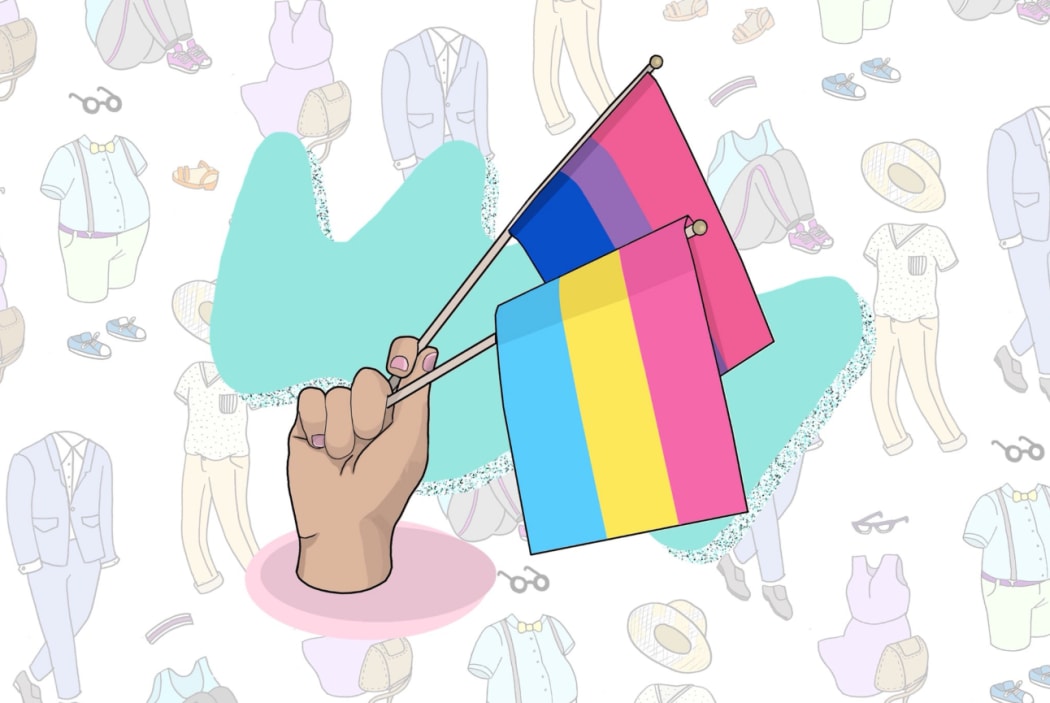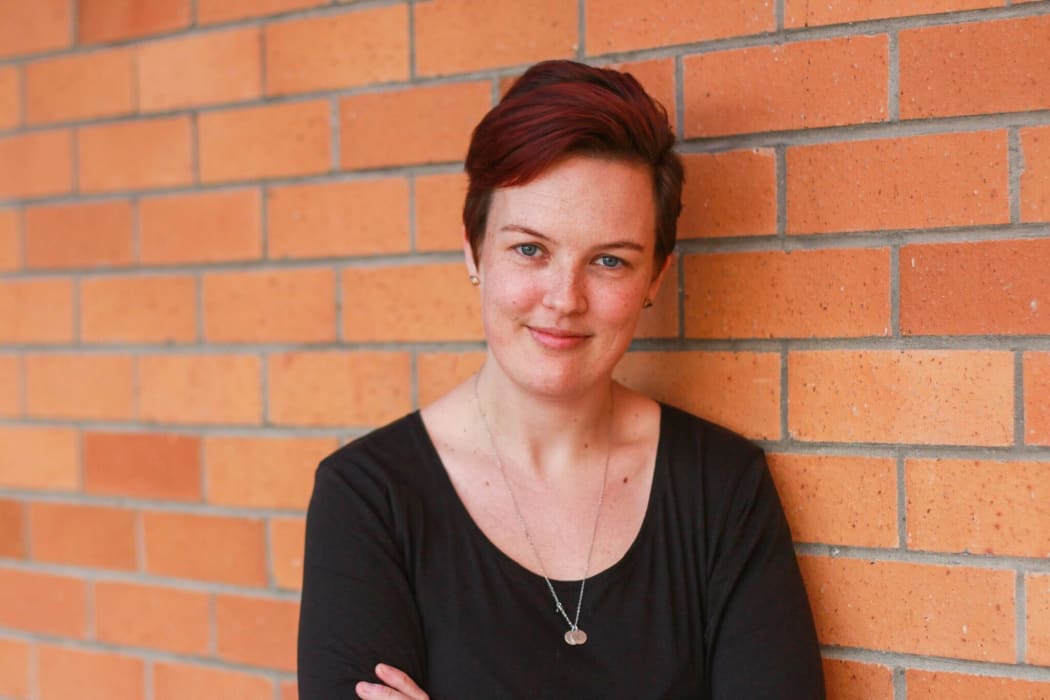There are at least as many bi and pansexual people in the world as lesbians and gay men combined, at least according to surveys of western countries. But bisexuality is poorly understood - leaving bi and pansexual people feeling that their sexuality is invisible or invalid.
In Episode 1 of the new season of BANG!, people who are “attracted to more than one gender” share their experiences, and Dr Nikki Hayfield highlights some particularly damaging, often “biphobic”, stereotypes.

Photo: RNZ / Pinky Fang
To the outside world, Rose and Sam* look like any other straight couple. They’re in their mid 20s, affectionate and obviously really into each other. The thing is, they’re not straight.
Sam identifies as pansexual and Rose is bisexual. People define each of these sexualities in different ways, but for Sam pansexuality means that he’s attracted to people irrespective of gender (as in, it’s not important) and for Rose bisexuality means she’s attracted to people “across the spectrum of genders.”
For those shouting “but bi means two!”, some people still use bisexuality to mean they’re into just men and women, but others have broadened the definition as a response to the increase in trans identities and in resisting binary understandings of gender.
Both Sam and Rose came out in their early 20s, both had same-sex experiences and attractions in their teens and, initially, both put them down to teenaged “confusion” or “acting out”.
As Sam puts it, “Heterosexuality was expected of me and that’s why it took quite a while to realise I wasn’t that. It’s why my parents still don’t know [I’m pan]… I wouldn’t be disowned or anything, but it would confirm that I’m the sort of black sheep, and that I’m less of a man in some way, and that doesn’t feel good.”
Rose grew up with an openly lesbian aunt, her family environment was welcoming of queerness. But she thought bisexuality meant 50% attracted to men and 50% attracted to women, and that the label didn't fit her because she’s attracted to men more of the time.
That’s until she turned 21 and stumbled across a Tumblr post.
“It said, ‘you can be 70% attracted to men, 30% attracted to women’ and I was like ‘Oh! I think I could be not-straight then!’”
Today is the only day you’ll be able to see these pie charts so please pay attention #BiVisibilityDay pic.twitter.com/bmbKwEn5Mw
— Wei Ming Kam (@weimingkam) September 23, 2018
Soon after, Rose came out to her Mum.
“When I told her… she was like ‘Oh, I think I’m bi too!’, I was like, ‘What?! Why didn’t you tell me! That would’ve really helped my coming out journey if you’d told me’,” she laughs.
Rose's Mum explained she had tried to come out as bi to some lesbian friends in the 1980s, but they told her she needed to “pick a side”. This kind of discrimination from within queer circles makes bisexuals particularly vulnerable to social isolation, with many reporting that they feel "not straight enough" for straight circles and "not gay enough" for LGBTQ+ communities.
Rose and Sam are part of an open and supportive friend group, but even so - people close to them make incorrect assumptions about their sexualities because they are in a male/female relationship.
“We have had a friend who we know and love so much come up to us really drunk… and be like, ‘You’re just so straight! Look at you two!’... and I was like, ‘No we’re not!’ It was sort of a funny situation but also… I don’t think it’s a funny joke to be like ‘you’re straight, haha!’ Because you just don’t know,” she says.
Dr Nikki Hayfield is a senior lecturer at UWE Bristol, whose research explores bisexualities, pansexualities, asexualities, and LGBTQ+ sexualities generally. She’s also bisexual herself.
“People do tend to take our relationships status as a signifier of our identity, and so it’s much more difficult for bisexual people to be out about their sexuality, because their partner… doesn’t indicate their sexuality in the way that it does for heterosexual people or for lesbians and gay men,” she says.
“Bisexual people find that even if they’ve been explicitly out about their bisexuality, to say their friends and their family and their work colleagues, when they’re in a relationship all of a sudden it’s as if they didn’t make that declaration of their bisexuality, and they find that people around them assume that they’re ‘gay now’ or they’re “straight now’.“

Emily Writes Photo: Supplied
Author and columnist Emily Writes was happily married to her husband when she came to terms with her attractions towards women. While her husband was incredibly supportive, coming out to some of her friends and family was trickier.
“A lot of people saw it as ‘Are you getting a divorce then? Which I thought was really odd because that never crossed out minds… We have a really happy marriage and I don’t see how that changes anything,” says Emily.
As someone with a public profile, Emily copped the same social media flack as bisexual celebrities like Lady Gaga and Miley Cyrus: That they are claiming queer sexualities as a marketing stunt. Another common biphobic trope.
“When I see somebody being like ‘Oh now she’s gay coz it’s cool.’ I just have this thing in my head where I’m like ‘I’ve been gay! I’ve been gay! The whole time I was gay!’ She says. “It’s this thing around bisexuality or queerness, that people want you to perform it for them and if you don’t then are you allowed to say that you’re queer or bi?”
Here’s why this stuff is so important:
The Youth ‘12 survey, of 8,500 New Zealand secondary school students found young people who experience “both and same sex attraction” (gay, lesbian, bi and pansexual students were lumped together in this survey) are more likely to be bullied.
The majority of them had deliberately self-harmed. 18.3% had attempted suicide in the past year.
Also - the proportion of them experiencing significant depressive symptoms has increased from 27% in 2001 to 41.3% in 2012. Opposite-sex attracted students had no significant change.
Several overseas studies also suggest that bisexual people are at a higher risk for poor mental health outcomes than both straight and lesbian and gay people.
What can we do to help?
Sai, Charlie and Emma are students at Wellington High School who identify as pan and bisexual.
“Just normalise it. As much as you can,” says Emma. “A lot of tv shows are having a lot of casual background queer characters and not making their queerness who they are… Let’s hope it continues.”

Tessa Thompson (Thor Ragnarok), Chance Perdomo (The Chilling Adventures of Sabrina), Stephanie Beatriz (Brooklyn Nine Nine), Vanessa Morgan (Riverdale) and Robert Sheehan (The Umbrella Academy). Photo: RNZ
“I do think the term “it’s just a phase’ is so strange,” Charlie says. “Because, if it is a phase why can’t that person, like, live in that phase and be comfortable with that?”
“People are a lot more quick to shut it down the younger you are because they’re like ‘oh you don’t know any better’,” says Emma.
“It’s just people with ideas about what things should be, having a go at people who don’t fit their expectations, just like it happens with just your regular old homophobes,” says Sai.
“I guess I just wish I had bi parents, then I’d know it was a thing. Or just bi people that are open and in my life,”
Rose, the bi woman in a relationship with pansexual Sam, has some good advice, too.
“Until I meet this new person coming into my friends life, I’m not gonna presume what gender they’re going to be, that’s just putting my friend in a box... I kinda just assume everyone’s bi unless they tell me otherwise.”
*Rose and Sam are not their real names

